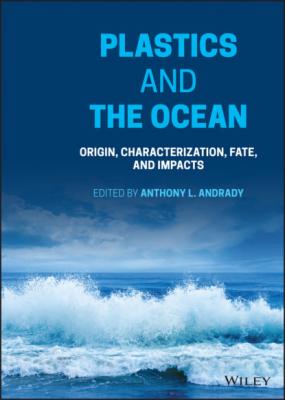Plastics and the Ocean. Группа авторов
Читать онлайн.| Название | Plastics and the Ocean |
|---|---|
| Автор произведения | Группа авторов |
| Жанр | Химия |
| Серия | |
| Издательство | Химия |
| Год выпуска | 0 |
| isbn | 9781119768418 |
2.2.5 Impact Modifiers
Impact modifiers (IMs) are a class of toughening functional additives that increase the impact strength of the plastic articles. Many commodity thermoplastics, such as PVC and PS, are brittle at ambient conditions (i.e., poor impact strength) and easily undergo cracking and crazing. In order to meet the physical requirements for certain applications, an IM additive is used. IMs are elastomeric and rubbery and have a lower modulus than the host polymer system. When effectively dispersed into the polymer matrix, the rubbery phase of the IM acts to absorb or dissipate the energy from impact in order to stop craze or crack propagation. IMs can be grafted to the polymer during polymerization or physically blended during compounding. Styrenic oligomers/copolymers, such as ABS and methyl methacrylate‐butadiene‐styrene, make up the largest category of IMs, accounting for about 45% of the market (Markarian 2004). These along with acrylics that command 30% of the market and are used mostly in PVC. Elastomers, including ethylene‐propylene‐diene terpolymer (EPDM) and thermoplastic elastomers, make up about 10% used with polyolefins. The remainder is made up of chlorinated polyethylenes (CPE) and other types. IMs, such as ABS, EPDM, and CPE, are also “stand‐alone” plastic products. These materials are used as IMs in their oligomeric forms (i.e. MWs of 5000–20 000 g/mol; Ambrogi et al. 2017). Similar to plasticizers and FRs, IMs are often used at relatively high concentrations in the plastic formulation. However, since most IMs are large molecules, leaching from the plastic into the environment has not been a major concern.
Table 2.3 Examples of common antioxidant additives used in plastics.
| Chemical name | Antioxidant class | Structure |
|---|---|---|
| Pentaerythritol tetrakis[3‐[3,5‐di‐tert‐butyl‐4‐hydroxyphenyl] propionate | Hindered phenol |
|
| Octadecyl‐3‐[3,5‐di‐tert‐butyl‐4‐hydroxyphenyl] propionate | Hindered phenol |
|
| Tris(2,4‐di‐tert.‐butylphenyl)phosphite | Phosphite |
|
| Trisnonylphenyl phosphite | Phosphite |
|
| Dialkyl ester of thiodipropionic acid | Thioester |
|
| N,N‐Octadecyl hydroxylamine | Hydroxylamine |
|
2.2.6 Lubricants
Lubricants are added to polymer formulations to ensure homogenous flow, uniform compositions, and quick release during processing and molding. There are three main types of lubricants: anti‐slip agents that reduce the coefficient of friction of the plastic laminates; external lubricants that coat the metal/polymer interface during processing to minimize the plastic from sticking to the machinery; and a third group of low mass compounds that promote the flow of the polymer in the melt (Brydson 1999). Some of the most commonly used lubricants in thermoplastics are fatty acid amides (primary erucamide and oleamide), fatty acid esters, metallic stearates (e.g. zinc stearate), silicones, and waxes (Bhunia, et al. 2013). There is not much information available on the toxicity of lubricants (Andrady and Rajapakse 2019). However, some lubricants are nonylphenol based, which are known as endocrine disruptors (Boehme et al. 2010).
2.2.7 Light Stabilizers
Plastics are also susceptible to degradation via photo‐oxidation, which is the result of the combined action of light and oxygen, that follows a similar oxidation cycle as in thermal oxidation that was previously discussed (see also Chapter 8). Light stabilizers interfere with the physical and chemical processes of light‐induced polymer degradation. The most important light stabilizer classes are benzophenones, benzotriazoles, organic nickel compounds, and sterically hindered amines (HALS; Jia et al. 2007). UV absorbers, such as benzophenones and benzotriazoles, are extensively used to stabilize thick sections of polyolefins, poly(ethylene terephthalate) (PET), polyurethane (PU), poly(vinyl acetate) (PVA), natural rubber, and epoxy formulations. Organic nickel compounds quench or deactivate the excited states of chromophores arresting oxidation. HALS is a particular potent free‐radical quencher that is effective at very low concentrations (≈0.1%).
The protection of plastics from the effects of light can also be achieved through the addition of carbon black (CB) and other pigments such as titanium dioxide (Accorsi et al. 2001) that essentially shield the plastic from UV radiation. Light stabilizers significantly control the weathering of plastics exposed to sunlight as well as fragmentation via loss of MW from photo‐oxidation of the polymer. Typical loadings in plastics are relatively low, with <1%, and migration and toxicity have not received special attention.
2.2.8 Colorants
Colorants are chemical compounds that not only impart color to plastic materials but can also affect other properties, such as weather resistance, light stability, and transparency of the plastic. Colorants fall into two distinct classes: dyes and pigments; main distinction being dyes are soluble in the plastic matrix while pigments are insoluble. Most commonly used are the azo dyes that make up >50% of all dyes listed in the Color Index (Ambrogi et al. 2017) and used in textiles, paper, leather, rubber, or even foodstuffs (Ambrogi et al. 2017). Since organic dyes dissolve in the polymer, they do not scatter but only absorb light. Therefore, even at high concentrations of the dye, the plastic tends to be transparent or translucent. Some dyes such as aromatic amines, are known carcinogens and phthalocyanines have detectable estrogenic activity (Yang et al. 2011).
Pigments remain discrete particles that are well dispersed in the polymer matrix (Bolgar et al. 2016). Scattering and absorption of light by the pigment particles makes the plastic partly opaque (Andrady and Rajapakse 2019). Pigments are classified as either organic or inorganic. Organic pigments include benzimidazoles, quinacridones, and mono‐azos and provide the most brilliant opaque colors available
